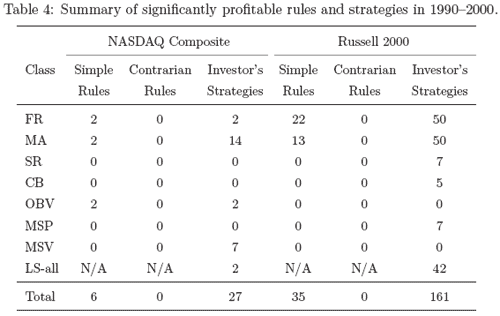In their March 2005 paper entitled “Re-Examining the Profitability of Technical Analysis with White’s Reality Check and Hansen’s SPA Test”, Po-Hsuan Hsu and Chung-Ming Kuan examine the profitability of a very large universe of technical trading rules and strategies against the Dow Jones Industrial Average (DJIA), S&P 500, NASDAQ Composite and Russell 2000 stock indexes. Their approach and findings, using data from 1989-2002, are as follows:
The authors consider a universe of 39,832 simple trading rules, simple contrarian rules and investor strategies, defined as follows:
- 18,326 simple rules in 12 classes: Filter Rules (FR), Moving Averages (MA), Support and Resistance (SR), Channel Break-Outs (CB), On Balance Volume Averages (OBV), Momentum Strategies in Price (MSP), Momentum Strategies in Volume (MSV), Head and Shoulders, Triangle, Rectangle, Double Tops and Bottoms and Broadening Tops and Bottoms.
- 18,326 simple contrarian rules that are the opposite positions of the preceding simple rules.
- 3,180 investor strategies based on the information generated from many simple rules in three classes: learning strategies (LS – following the best-performing rule within a rule class), voting strategies (across the trading rules in a rule class) and position changeable strategies (allowing weighted positions).
In applying all these rules and strategies against the four major stock indices identified above, the authors conclude that:
- The best simple rules are:
- For the DJIA, a momentum strategy in volume rule (NOT SIGNIFICANT)
- For the S&P 500, a contrarian on balance volume rule (NOT SIGNIFICANT)
- For the NASDAQ, a two-day moving average rule (HIGHLY SIGNIFICANT)
- For the Russell 2000, a two-day moving average rule (HIGHLY SIGNIFICANT)
- Most profitable rules and strategies for the NASDAQ and Russell 2000 are constructed from filter rules and moving averages rules. (See the table below from the paper.)
- No contrarian rule is significantly profitable.
- All of the profitable investor strategies are learning strategies, and there are many more profitable investor strategies than there are profitable simple rules. In fact, there are profitable investor strategies that are based on non-profitable simple rules. Technical investors are apparently able to extract and enhance information from simple rules.
- After accounting for transaction costs, the best rules and strategies generally beat a buy-and-hold strategy for both in-sample and out-of-sample periods.

In summary, technical analysis can be significantly profitable when applied to relatively immature stock indices (NASDAQ Composite and Russell 2000) but not when applied to mature stock indices (DJIA and S&P 500). Speed of information dissemination and liquidity for stocks within an index may be critical to the success of technical analysis on that index.
Reader Wes Williams offered the following observations and recommendation:
I carefully read (and re-read) the source paper and then wrote some TradeStation programs to apply their results into 2003-present for the Russell 2000 index.
The results are quite disappointing. I then wondered why Hsu and Kuan did not publish more specifics about the parameters used in their moving averages and learning programs. In their conclusion on page 20 of 27, their out-of-sample results were bad enough for me to avoid the entire methodology. After transaction costs in 2002, they report a 48% loss in comparison with a 22% loss for buy-and-hold! Their 10-year in-sample result cannot count since it is, after all, a sampling to set parameters for the next two years.
There is, of course, much more to be said on this subject. I used to be a Hedge Fund Manager in a partnership and have written thousands of such strategies and walk-forward-tested them. I applaud them for applying scientific disciplines – if only more people would – but trading a system with a 48% drawdown in a first sample of a walk-forward test? I wouldn’t be able to sleep at night wondering if the system simply doesn’t work any longer.
My reproduction of their test indicates that it has stopped working.